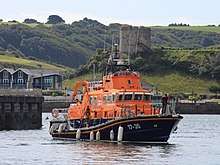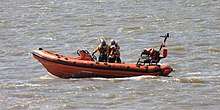Plymouth Lifeboat Station
Plymouth Lifeboat Station is the base for Royal National Lifeboat Institution (RNLI) search and rescue operations at Plymouth in England. The first lifeboat was stationed in the city in the early 1800s. The station moved to its present site at Millbay Docks in 1992, a Grade II-listed three-storey tower. Since 2003 it has operated a Severn-class all weather boat (ALB) along with an Atlantic 75 inshore lifeboat (ILB).
| Plymouth Lifeboat Station | |
|---|---|
 | |
 Location within Devon | |
| Former names | Millbay Customs Office |
| General information | |
| Type | Lifeboat station |
| Address | Custom House Lane |
| Town or city | Plymouth, Devon |
| Country | England |
| Coordinates | 50.36301°N 4.15038°W |
| Current tenants | Royal National Lifeboat Institution |
| Completed | 1850 (as customs office) |
| Design and construction | |
| Architect | George Wightwick |
| Designations | Grade II |
| Website | |
| www | |
History
Plymouth was one of the towns that received one of the Lloyds North Country-class lifeboats in the first decade of the nineteenth century, but it never saw service. In 1825 a new lifeboat was provided by the new National Institution for the Preservation of Life from Shipwreck (which was renamed the Royal National Lifeboat Institution in 1854), but this too saw no use.[1]
A new lifeboat station was established in Plymouth in 1862 with a lifeboat house on the West Wharf of the outer basin of Millbay Docks. This was replaced in 1897 by a new boathouse at the Camber (at the seaward end of the wharf) with its own 130-foot (40 m) launching slip which allowed the lifeboat to get to sea more quickly. The station's first motor lifeboat was a Barnett-class which had to be kept moored afloat due to its 60-foot (18 m) length. A new station was built on the Princess Royal Pier in 1979 and a new mooring was provided alongside. From 1988 until 1992 the lifeboat was moored in Sutton Harbour while the area around the Princess Royal Pier was redevloped as a marina, but it then returned to Millbay.[2][3]
An Inshore Rescue Boat (IRB) was first stationed at Plymouth in May 1967. After a year when this was a D class inflatable, larger ILBs were provided. Initially in the form of 18-foot (5.5 m) Hatch and McLachlan lifeboats, but since 1983 by 7.5-metre (25 ft) Atlantic 75s.[4]
Service awards
A number of rescues carried out by the station's lifeboats have been recognised by letters, certificates and medals from the RNLI management, including three that resulted in a total of four bronze medals.
- Coxswain Walter Crowther was awarded a medal after the Robert and Marcella Beck was called out on 13 January 1942 (during the Second World War) to a Sunderland flying boat of the Royal Australian Air Force which had been blown onto rocks in a storm. The lifeboat crew managed to get a rope across to the flying boat and towed her and her crew to safety.[5]
- Another medal was awarded to Coxswain John Dare "for his courage, determination and excellent seamanship" on 16 January 1974. A Danish coaster, the Merc Enterprise had capsized 26 miles (42 km) south of Rame Head. The lifeboat Thomas Forehead and Mary Rowse fought through hurricane-force winds to reach the casualty. A helicopter managed to winch seven people out of the water while the lifeboat searched for other survivors but failed to find any.[6]
- The third bronze medal rescue involved the Thomas Forehead and Mary Rowse II on 15 February 1978. The Elly Gerda ran aground near Looe in a Force 8 storm. The lifeboat managed to rescue two of the trawler's crew but the heavy seas then washed the trawler off the rocks. The lifeboat escorted it back into harbour and then returned to Plymouth, where it had left its berth nearly 14 hours earlier. The RNLI awarded medals to both the Coxswain, Patrick Marshall, and the Mechanic, Cyril Alcock, "for their courage, determination and seamanship".[7]
Facilities
Since 1992 the all weather lifeboat has been moored afloat in the Millbay Marina, which is on the eastern side of the outer basin. The inshore lifeboat is kept next to it in a floating cradle.[8]
Crew facilities and storage are in the old Customs Office on the quay close to the moorings. This is a Grade II Listed building which was erected in 1850 to the design of George Wightwick. It is built from granite, octagonal in plan and three storeys high. This gave the customs officers all-round views of the area.[9][10][11]
Area of operation
The RNLI aims to reach any casualty up to 50 miles (80 km) from its stations, and within two hours in good weather. To do this the Severn class lifeboat at Plymouth has an operating range of 250 nautical miles (460 km) and a top speed of 25 knots (46 km/h).[12] The Atlantic 75 can go out in Force 7 winds (Force 6 at night) and can operate at up to 32 knots (59 km/h) for 2½ hours.[13] Adjacent all-weather lifeboats are stationed at Salcombe to the east, and Fowey to the west. There is also an ILB at Looe between Plymouth and Fowey.[8]
Current lifeboats

- Severn-class 17–35 (ON 1264) Sybil Mullen Glover – on station since 2003[14]
- Atlantic 75 B775 Millennium Forester – on station 2004–05 and again since 2006[15]
Former lifeboats
'ON' is the RNLI's sequential Official Number; 'Op. No.' is the operational number painted onto the boat.
Pulling and sailing lifeboats
| ON | Name | Built | At Plymouth | Class |
|---|---|---|---|---|
| –[1] | – | ? | 1800s | North Country |
| –[1] | – | 1825 | 1825–? | Newbury |
| –[5] | Prince Consort | 1862 | 1862–1873[Note 1] | Peake |
| –[5] | Clemency | 1873 | 1873–1885 | Peake |
| 44[5][16] | Escape | 1885 | 1885–1898 | Peake |
| 412[17] | Eliza Avins | 1898 | 1898 –1922 | Peake |
| 531[18] | Brothers Freeman | 1904 | 1922–1926[Note 2] | Peake |
Motor lifeboats
| ON | Op. No. | Name | Built | At Plymouth | Class |
|---|---|---|---|---|---|
| 696[19] | – | Robert and Marcella Beck | 1926 | 1926–1952[Note 3] | Barnett |
| 890[20] | – | Thomas Forehead and Margaret Rowse | 1952 | 1952–1974[Note 4] | Barnett |
| 1028[21] | 44-010 | Thomas Forehead and Margaret Rowse II | 1974 | 1974–1987[Note 5] | Waveney |
| 1136 | 52-40[22] | City of Plymouth | 1987 | 1988–2002[Note 6] | Arun |
Inshore lifeboats

| Op. No. | Name | Built | At Plymouth | Class | Type |
|---|---|---|---|---|---|
| D-130[23] | – | 1967–1968 | D | Zodiac 3 | |
| 18-01[24] | – | 1967 | 1968–1972 | A | Hatch |
| A-509[24][Note 7] | – | 1972 | 1972–1977 | A | McLachlan |
| A-507[24] | – | 1973 | 1977–1983[Note 8] | A | McLachlan |
| B-775[15] | Millennium Forester | 2001 | 2004–2005[Note 9] | B | Atlantic 75 |
| B-700[25] | Susan Peacock | 1993 | 2005–2006[Note 10] | B | Atlantic 75 |
| B-769[15] | Coventry and Warwickshire | 2001 | 2005–2006[Note 11] | B | Atlantic 75 |
Notes
- Prince Consort was withdrawn following damage incurred while rescuing 12 people from two vessels in a gale on 8 December 1872.
- Brothers Freeman had been the Littlehampton Lifeboat before being transferred to Plymouth.
- Robert and Marcella Beck was requisitioned by the Admiralty and stationed in Iceland during World War II. Its place was taken by the Minister Anseele, a Belgian lifeboat. Plymouth's lifeboat returned to station in 1947 but was sold in 1952. It was reported in use as a pleasure boat at Hamburg in 2008 carrying the names Blasbeg/Idle Hours
- Thomas Forehead and Margaret Rowse served in the RNLI relief fleet until 1981. It was sold two years later and was reported in 2009 as being at Larne having been converted to a pleasure boat and renamed Ornsay.
- Thomas Forehead and Margaret Rowse II was stationed at Fowey until 1996 and then spent some time in the relief fleet before being withdrawn from service in 1997. In 1999 it was sold to the New Zealand Coastguard and was stationed at New Plymouth where it is named Westgate Rescue.
- City of Plymouth was in the relief fleet until 2004. The following year it was sold for further service as a lifeboat at Skagaströnd in Iceland where it is named Hunabjorg.
- A-509 was originally numbered 18-009 in the ALB series, but the McLachlan and Hatch lifeboats were later renumbered in the ILB series.
- A-507 was replaced by A-506 for a period during 1979 and 1980.
- Millennium Forester saw use in the relief fleet for a while before returning to Plymouth in 2006.
- Susan Peacock was the first Atlantic 75 lifeboat, a total of 97 being built between 1993 and 2003. Since 2006 it has been part of the RNLI training fleet.
- Coventry and Warwickshire was built as the Weston-super-Mare Lifeboat and returned to that station.
See also
References
- Leach, Nicholas (2009). Devon's Lifeboat Heritage. Chacewater: Twelveheads Press. p. 30. ISBN 978-0-906294-72-7.
- Langley, Martin (1987). Millbay Docks. Port of Plymouth Series. Exeter: Devon Books. p. 7. ISBN 0-86114-806-1.
- Leach (2009). Devon's Lifeboat Heritage. pp. 31–34.
- Leach (2009). Devon's Lifeboat Heritage. p. 35.
- Leach (2009). Devon's Lifeboat Heritage. p. 31.
- Leach (2009). Devon's Lifeboat Heritage. p. 33.
- Leach (2009). Devon's Lifeboat Heritage. p. 34.
- Denton, Tony (2010). Handbook 2010. Shrewsbury: Lifeboat Enthusiasts Society. p. 68.
- Historic England. "Former dock police station and custom office at South East entrance to Millbay Docks (1113301)". National Heritage List for England. Retrieved 2019-08-11.
- Kittridge, Alan (1993). Plymouth: Ocean Liner Port of Call. Truro: Twelveheads Press. pp. 13, 115. ISBN 0-906294-30-4.
- "Station History". Plymouth Lifeboat Station. Retrieved 2019-05-03.
- Wake-Walker, Edward (2008). The Lifeboats Story. Stroud: Sutton Publishing. pp. 110–111. ISBN 978-0-7509-4858-6.
- "Atlantic 75 and 85 (B Class)". RNLI. Retrieved 2010-12-02.
- Denton (2010). Handbook 2010. p. 42.
- Denton (2010). Handbook 2010. p. 52.
- Denton (2010). Handbook 2010. p. 2.
- Denton (2010). Handbook 2010. pp. 10–11.
- Denton (2010). Handbook 2010. pp. 14–15.
- Denton (2010). Handbook 2010. pp. 20–21.
- Denton (2010). Handbook 2010. pp. 28–29.
- Denton (2010). Handbook 2010. pp. 34–35.
- Denton (2010). Handbook 2010. pp. 38–39.
- Denton (2010). Handbook 2010. p. 55.
- Denton (2010). Handbook 2010. p. 43.
- Denton (2010). Handbook 2010. p. 50.
External links
| Wikimedia Commons has media related to Plymouth Lifeboat Station. |